Kyushojutsu: Basic Theory
By Joe Swift (Mushinkan Dojo, Kanazawa,
Japan)
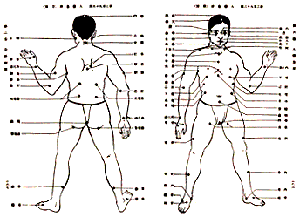
In recent years, karataka
all over the world have begun to reexamine
and study their classical Okinawan kata.
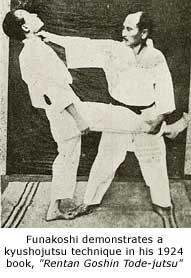 Practical
applications have been a major focus of
much of this research, and one of the key
components of practical applications is
the science of well-placed blows to vital
areas, pressure points or acupuncture points.
This study is called kyushojutsu in Japanese. Practical
applications have been a major focus of
much of this research, and one of the key
components of practical applications is
the science of well-placed blows to vital
areas, pressure points or acupuncture points.
This study is called kyushojutsu in Japanese.
The first article in this
series examined the historical development
of this art in Okinawa and Japan. This article
continues the examination by focusing on
the basic theories behind the art.
Kyushojutsu can be, and often
is, explained in terms of two different
medical paradigms: Traditional Chinese Medicine
(TCM) and Modern Western Medicine (MWM).
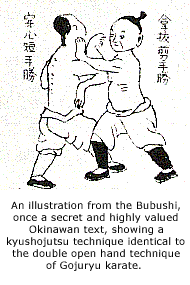 More
often than not, the two camps seem to be
at odds with each other as to which approach
is more valid. However, in this author's
opinion, either is fine, and people can
probably "pick their poison" so
to speak. More
often than not, the two camps seem to be
at odds with each other as to which approach
is more valid. However, in this author's
opinion, either is fine, and people can
probably "pick their poison" so
to speak.
What To Call The Vital
Points
As much of the original theory
behind kyushojutsu lies in the Traditional
Chinese Medicine (TCM) paradigm, many proponents
in the West use the international acu-point
code as nomenclature. Others utilize terminology
that is more in line with Modern Western
Medicine (MWM), citing nerves and muscles,
etc.Still others prefer to use different
Asian medical or martial arts terms (Japanese,
Chinese, Korean, etc.) to describe the locations
of the points. Adding to the confusion is
the fact that while Traditional Chinese
Medicine acu-points and Western Medicine's
neurological points are often the located
on the same body point, other times they
are not.
Kyushojutsu Understood
In Terms Of Traditional Chinese Medicine
The TCM paradigm makes use
of the principles of acupuncture (qi flow,
balance and interrelationships) to describe
its methods and effects. Perhaps a short
description of the meridians may be in order
here.
 Centuries
ago in China, doctors discovered "passageways"
of energy flow, which are called meridians
(a geographical term) in English (McCarthy,
1995). There are 12 major bilateral meridians,
for various internal organs. They are: Lung,
Large Intestine, Stomach, Spleen, Heart,
Small Intestine, Bladder, Kidneys, Pericardium,
Liver, Gall Bladder, and the Triple Warmer. Centuries
ago in China, doctors discovered "passageways"
of energy flow, which are called meridians
(a geographical term) in English (McCarthy,
1995). There are 12 major bilateral meridians,
for various internal organs. They are: Lung,
Large Intestine, Stomach, Spleen, Heart,
Small Intestine, Bladder, Kidneys, Pericardium,
Liver, Gall Bladder, and the Triple Warmer.
In addition, there are other
important meridians not associated with
organs (often called Extra Meridians, or
Extraordinary Vessels), two of which run
vertically along the frontal and posterior
center-line, the Conception Vessel (or meridian)
and the Governing Vessel (or meridian),
respectively.Along these meridians are numerous
points or "holes" (Sato, 1996)
through which energy can be transferred,
or the flow of energy can be modified, through
needles, fingertips, or heat in medical
application, or though trauma in defensive
application. These meridians can be broken
down into either yin (negative) or yang
(positive).
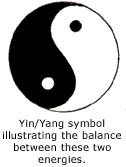 In
TCM for health to be maintained, yin energy
and yang energy must be balanced within
the body (Sato, 1996). The medical arts
such as acupuncture, shiatsu, and kikoo
(qi gong in Chinese) seek to restore this
balance. In contrast, kyushojutsu, in simple
terms, In
TCM for health to be maintained, yin energy
and yang energy must be balanced within
the body (Sato, 1996). The medical arts
such as acupuncture, shiatsu, and kikoo
(qi gong in Chinese) seek to restore this
balance. In contrast, kyushojutsu, in simple
terms, 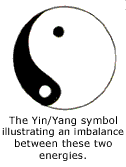 can
be viewed as attacking this balance, or
the flow of energy, within the body to cause
bodily damage to the opponent. can
be viewed as attacking this balance, or
the flow of energy, within the body to cause
bodily damage to the opponent.
One method of using vital
point or acu-point strikes employs The Five
Element Theory. Some schools of TCM categorize
the body's organ meridians into five separate
but interrelated elements, namely Fire,
Water, Earth, Metal and Wood (Sato, 1996).
This is known as the Five Element Theory
(FET) which is used to understand how energies
related to these elements, which are associated
with organs, interrelate, balance, nurture
or regulate each other.
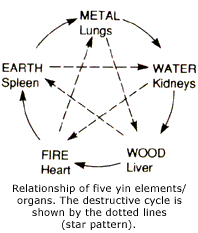
The simplistic method of
utilizing the FET in kyushojutsu is to follow
what is known as the Destructive Cycle.
This,is done by attacking the meridians
in a specific order to inflict damage upon
the opponent by disrupting the flow of energy
that regulates (destroys or absorbs) the
succeeding or related meridian in the cycle.
The Destructive Cycle can be easily remembered
by the following formula: Metal cuts Wood;
Wood drains nutrition from Earth; Earth
absorbs Water; Water puts out Fire; and
Fire melts Metal (Sato, 1996; Nakayama,
1998).
Yet another way to apply the
kyushojutsu is to attack the meridians during
specific time frames, known as shichen in
Chinese (McCarthy,1995). 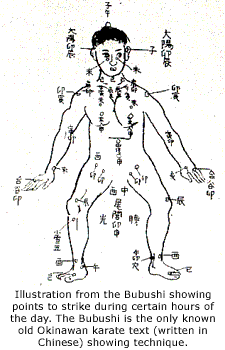 This
theory states that the energy and blood
flow through the meridians is strongest
during a specific time of day, corresponding
the 12 meridians with 12 two hour periods
of the old Chinese clock (McCarthy, 1995;
Sato, 1996; Nakayama, 1998). The shichen
are broken down into the hours of the Rat,
Bull, Tiger, Rabbit, Dragon, Snake, Horse,
Ram, Monkey, Bird, Dog, and Boar, respectively
(McCarthy, 1995; Sato, 1996; Nakayama, 1998). This
theory states that the energy and blood
flow through the meridians is strongest
during a specific time of day, corresponding
the 12 meridians with 12 two hour periods
of the old Chinese clock (McCarthy, 1995;
Sato, 1996; Nakayama, 1998). The shichen
are broken down into the hours of the Rat,
Bull, Tiger, Rabbit, Dragon, Snake, Horse,
Ram, Monkey, Bird, Dog, and Boar, respectively
(McCarthy, 1995; Sato, 1996; Nakayama, 1998).
Tradtional Chinese Medicine
Versus Modern Western Medicine
Theories of applying kyushojitsu
through understanding Traditional Chinese
Medicine are not without their detractors,
most notably groups of practitioners who
research kyushojutsu through Modern Western
Medicine (MWM). The MWM approach is useful
in providing specific, concrete, scientific
examples as to why kyushojutsu works, referring
to nerve plexi, tendons, muscles, etc.
Proponents of the MWM approach
state that the body's neurological and other
systems are well understood and verified
scientifically. They point out that meridians
have never been scientifically verified
(to their satisfaction) and that the whole
concept of qi (or chi in Chinese) flies
in the face of MWM biochemical concept of
the body and its systems. Furthermore, since
most acu-points are the same or closely
located to neurological points, MWM adherents
suggest that a MWM approach makes more sense.
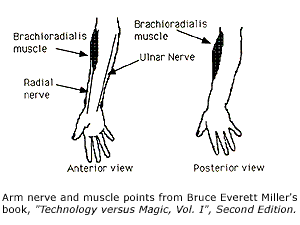
On the other hand, Traditional Chinese
medicine appears to be more "descriptive"
(for lack of a better word) in its application,
preferring to cite "natural" phenomenon
such as the Yin-Yang and Five Element Theory.
Supporters also point out that recent scientific
investigation of acupuncture has confirmed
that stimulation of certain acu-points has
produced certain organ and brain reactions
that can not be explained in terms of Modern
Western Medicine.
Even in Asian circles, however, some disagreement
exists about some of the TCM theories and
principles. In Japan, for example, the Yin-Yang
theory has been accepted in the Eastern
medical circles, but there seems to be some
apprehension about the Five Element Theory.
As far back as the Edo period (1603-1867),
the scholar Kaihara said that the Five Element
Theoryjust makes things "too complicated"
(Sato, 1996).
In China, the quanfa master He Yushan stated
that the striking of vital areas in terms
of the shichen (12 two hour time periods)
is preposterous, and later research showed
that the blood flow cannot be broken down
into 12 equal time periods through the 12
meridians (Jin, 1928).
Rather than bickering about which medical
paradigm is more correct, however, some
suggest that a better approach might be
to combine the two and come up with a concise
yet comprehensive explanation (Rench, 1999).
Numerology and Kyushojutsu
If things weren't confusing enough, another
aspect of the study of kata and its relation
to kyushojutsu is the seeming fascination
with numerology. Many tradtional kata (as
Gojushiho meaning 54 steps,Nijushiho or
24 steps,Seipai or 18 hands and Senseryu
or 36 hands) are named after numbers.
While many seem to think this might be
a Chinese phenomenon, it may have actually
been imported from India (Zarrilli, 1992).
While they are not the only numbers associated
with the fighting traditions, some of the
more prominent ones are 18, 36, 54, 72,
and 108. These numbers can be seen in Indian,
Chinese, and Japanese martial arts literature
(Jin, 1928; Zarrilli, 1992; McCarthy, 1995;
Sato, 1996) and within the names of kata.
One of the most common explanation of the
use of these numbers is that there are 108
effective vital points on the human body
(used in the martial arts), 36 of which
are fatal (Jin, 1928). Another school of
thought is that there are 36 vital points,
and 72 variations in attacking methodology,
making a total of 108 (McCarthy, 1995).
Yet another theory lists 36 fatal vital
points and 18 non-fatal points (Sato, 1996).
While the exact mechanism of the numerological
aspects of the fighting traditions may be
lost to antiquity, we are left with several
reminders of this ancient heritage in the
form of kata names and the number of effective
vital points.
About The Author:
Joe Swift, native of New York State (USA)
has lived in Japan since 1994. He holds
a dan-rank in Isshinryu Karatedo, and also
currently acts as assistant instructor at
the Mushinkan Shoreiryu Karate Kobudo Dojo
in Kanazawa, Japan. He is also a member
of the International Ryukyu Karate Research
Society and the Okinawa Isshinryu Karate
Kobudo Association. He currently works as
a translator/interpreter for the Ishikawa
International Cooperation Research Centre
in Kanazawa. He is also on the Board of
Advisors for FightingArts.com.
References:
1.Jin Yiming (1928). Secrets of Wudang
Boxing. Translation of section on Vital
Points, tr. P. and Y. McCarthy, 1994).
2. McCarthy, P. (1995) Bubishi: The
Bible of Karate. Tokyo: C.E.
Tuttle.
3. Nakayama T. (1998). Kassatsu Jizai
ni Naru (To Heal or Harm at Will). Tokyo:
BAB Japan Inc.
4. Rench, A. (1999). Classical Okinawan/Japanese
Pressure Points. Unpublished Document.
5. Sato K. (1996). Seiden Jissen Tenketsu-jutsu.
(Orthodox Dim Xue for Real Fighting) Tokyo:
Baseball Magazine.
6. Zarrilli, P. (1992) "To heal
and/or harm: The vital spots
(marmmam/varmam) in two south Indian martial
traditions." Journal of Asian Martial
Arts. Vol. 1:1 and 1:2.

back
to top
home
| about
us | magazine
| learning
| connections
| estore
|